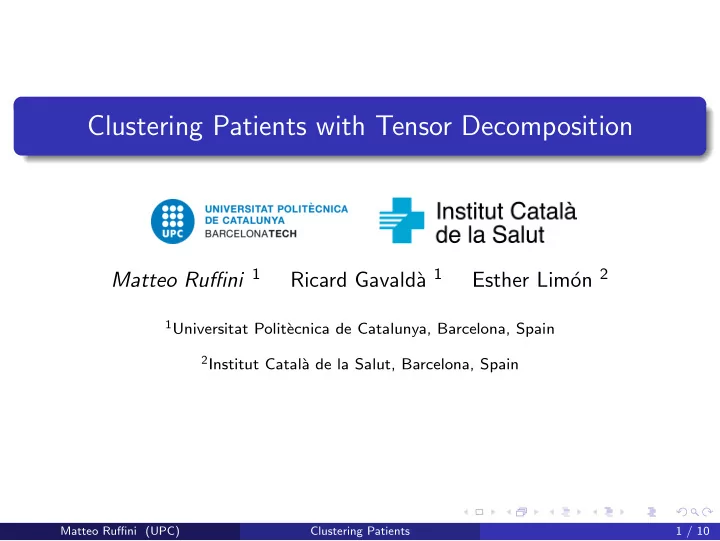

Clustering Patients with Tensor Decomposition Matteo Ruffini 1 a 1 on 2 Ricard Gavald` Esther Lim´ 1 Universitat Polit` ecnica de Catalunya, Barcelona, Spain 2 Institut Catal` a de la Salut, Barcelona, Spain Matteo Ruffini (UPC) Clustering Patients 1 / 10
Overview Task : to provide an automated and efficient method to segment patients in groups with similar clinical profiles. 1 Similar patients → Similar cares. 2 Find recurrent comorbidities. 3 Assigning and planning resources: drugs and doctors. Matteo Ruffini (UPC) Clustering Patients 2 / 10
Overview Task : to provide an automated and efficient method to segment patients in groups with similar clinical profiles. 1 Similar patients → Similar cares. 2 Find recurrent comorbidities. 3 Assigning and planning resources: drugs and doctors. Dataset : all hospital admissions in Catalonia in 2016 ( > 1 Mln records). Each row is a visit: up to 10 diagnostics in ICD-9 format. Matteo Ruffini (UPC) Clustering Patients 2 / 10
ICD-9 EHR In ICD code, to each disease is associated a number Records : list of patients with their diseases → patient-disease matrix. Diseases 820 401 278 560 Patient 1 820, 401 Patient 1 1 1 0 0 Patient 2 401, 278, Patient 2 0 1 1 0 Patient 3 560, 820, 278 Patient 3 1 0 1 1 Matteo Ruffini (UPC) Clustering Patients 3 / 10
ICD-9 EHR In ICD code, to each disease is associated a number Records : list of patients with their diseases → patient-disease matrix. Diseases 820 401 278 560 Patient 1 820, 401 Patient 1 1 1 0 0 Patient 2 401, 278, Patient 2 0 1 1 0 Patient 3 560, 820, 278 Patient 3 1 0 1 1 Objective : cluster the rows of the patient-disease matrix. Sparse and high dimensional data. Standard methods : k-means, k-medioids, single linkage ... Distance-based: poor performances on high dimensional sparse data. Matteo Ruffini (UPC) Clustering Patients 3 / 10
Modeling strategy Data is modeled as a mixture of independent Bernoulli variables Latent state → Medical status of a patient. Y Observed diseases depend on the patient status. . . . Once in a status, diagnostics are independent. x 1 x 2 x d Main advantages No distance required. Generative model → clear interpretation. Clustering is performed via MAP assignment. Matteo Ruffini (UPC) Clustering Patients 4 / 10
Learning procedure: method of moments 1 Retrieve from data estimates of the moments: � k i =1 ω i µ i ∈ R d M 1 = � k i =1 ω i µ i ⊗ µ i ∈ R d × d = M 2 � k i =1 ω i µ i ⊗ µ i ⊗ µ i ∈ R d × d × d = M 3 Where M = [ µ 1 , ..., µ k ] and ω = ( ω 1 , ..., ω k ) are the unknown centers of the mixture and the mixing weights. 2 Obtain mixture’s parameters with tensor decomposition on the moments: T D ( M 1 , M 2 , M 3 ) → ( M , ω ) Main challenge: To estimate the moments from data; we used an approximated approach. Matteo Ruffini (UPC) Clustering Patients 5 / 10
Experimental results - two subset datasets We focus on two subsets of our dataset: 1 Heart Failure Dataset : Patients having diagnostic 428 in the ICD-9 code (Heart Failure). 2 “Tertiary” Dataset: Patients with serious diseases to be treated in top hospitals. Both contain around 20000 patient records. Matteo Ruffini (UPC) Clustering Patients 6 / 10
Heart Failure Dataset - Content of the clusters Cluster ID : 1 2 3 4 5 Size : 7290 2915 4408 2936 5533 Matteo Ruffini (UPC) Clustering Patients 7 / 10
“Tertiary” Dataset - Content of the clusters Cluster ID : 1 2 3 4 5 6 Size : 4892 3982 1043 3133 819 2442 Matteo Ruffini (UPC) Clustering Patients 8 / 10
Clustering Patients with Tensor Decomposition Matteo Ruffini 1 a 1 on 2 Ricard Gavald` Esther Lim´ 1 Universitat Polit` ecnica de Catalunya, Barcelona, Spain 2 Institut Catal` a de la Salut, Barcelona, Spain Matteo Ruffini (UPC) Clustering Patients 9 / 10
Recommend
More recommend